Articles on Hand-knotted Carpets
Handmade Carpets
Pakistani Carpets and Rugs
5 min
The Pakistani Carpet are the most common and affordable flooring rugs typically made from Pakistani wool in cities like Hyderabad & Lahore. These carpets are actively sold both online and locally due to their popularity and the value they offer at a lower cost.
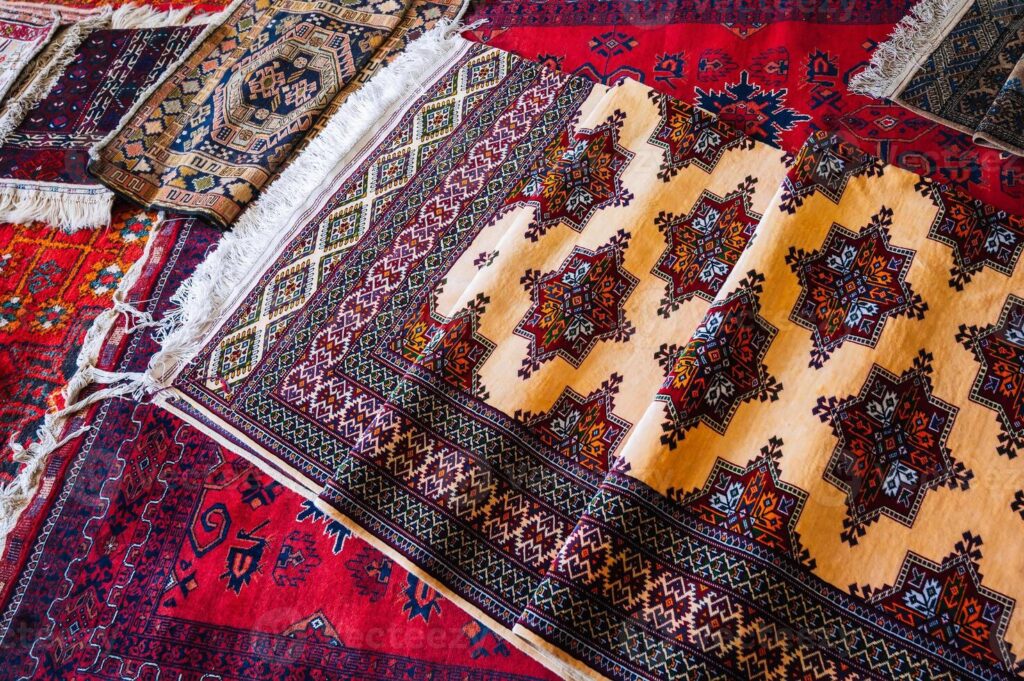
The Story & Demand of Pakistani Carpets
Pakistani carpets usually woven in cities like Lahore, Hyderabad and retailed in mainly Karachi. In today’s world, where machine-made products are everywhere, the taste of a handmade Pakistani carpet still stands because of the feel, durability, and a touch of antique. The Pakistani carpets are also exported to the countries including: Japan, USA & UAE also displayed in international rug exhibitions.
The art of carpet weaving in Pakistan is coming from the 16th century during the Mughal era. Emperor Akbar (1556–1605) invited Persian weavers to the subcontinent who introduced the skill to craft these handmade rugs. advanced weaving techniques and intricate designs.
Post-independence in 1947, Pakistan’s carpet industry officially began. The Pakistan Carpet Manufacturers and Exporters Association (PCMEA) was established in 1962 to promote and regulate the carpet sector. The industry reported about the exports reaching $278 million in 2005–06. However, challenges such as increased production costs, competition from neighboring countries, and policy shortcomings led to a decline, with exports falling to $97.68 million by the period of 2015–16. In 2023, carpet and floor covering exports reached $64.13 million. The PCMEA reported about the international markets, notably highlighted the rising demand in the U.S. and other global markets early 2025.
| Fiscal Year | Export Value (USD Million) |
|---|---|
| 2019–20 | $54.00 |
| 2020–21 | $60.99 |
| 2021–22 | $54.32 |
| 2022–23 | $64.13 |
How's the Pakistani Rugs are made
The process of creating these carpets is complex, involving patience, and dedication. No matters if it’s a hand-knotted rug or a flat-woven kilim, each carpet need to be planned and also to craft accordingly as well. The production period of Pakistani carpets is based on the specification of carpet. Approximately 2-3 weeks are required for smaller size and a larger size may take months to complete.
Step 1
Picking the Material
The first step in creating a Pakistani carpet is selecting the right materials. The quality of the raw materials is the most important aspect for the overall durability, texture and weight of the carpet.
Wool: The most common material used in Pakistani carpets is wool. It is durable, soft, and perfect for weaving. Wool is sourced from local sheep.
Cotton: Used as a foundation material, cotton provides a strong and flexible base for the carpet.
Silk: While less common, silk is used for high-end carpets. It gives shine and smooth texture to the carpet.
Step 2
Designing the Carpet
The design stage is critical for the creation of carpet. Designs can range from traditional/common patterns or customized styles. Designers help the weavers by creating a computerized structural map for the placement of every knot of each color.
Traditional Designs: Some of the most popular traditional designs include floral motifs, geometric patterns, and symbolic motifs that represent Pakistani culture.
Customization: Many Pakistani carpets are custom-made, allowing buyers to decide the specific color, size or patterns according to the need.
Step 3
Weaving the Carpet
Weaving the carpet is the part of the process, requiring skill and attention to detail. The techniques vary, but the two most common methods in Pakistani carpets are hand-knotting and flat weaving.
Hand-Knotting: In the hand-knotting method, individual knots are tied by hand around the warp threads. This method results in a dense, fine-quality carpet. The more knots per square inch (knot density), the higher value of the carpet.
Flat Weaving: This method involves weaving the threads without knots, creating a flat and thinner carpet. Kilim rugs are a good example of flat-woven carpets. While not as dense as hand-knotted carpets.
Step 4
Finishing and Washing
As the carpet is woven, it goes through a finishing process to that picks out the appearance and texture of carpet to the front.
Trimming and Edging: The edges of the carpet are trimmed and finished to give the rug a clean, polished look.
Washing: After the weaving and finishing, the carpet is washed to remove any dirt and excess dyes. This process also helps soften the wool and balance the natural dyes.
Types of Hand-Knotted Pakistani Carpets
Pakistani carpets have a wide range of designs, colors, and textures than other origin carpets. The different types of Pakistani rugs vary in terms of material, design, and weaves. They are categorized with unique names for identification, there’s no large gap among the prices of Pakistani carpets, the difference is based on the knot density & material usage.

Bokhara Carpets
Bokhara carpets are the common type of Pakistani Carpet due to their prefect combination with almost every interior for the bright red and maroon tones. The repeating geometric patterns and circular motif are identifier of these carpets. Bokhara carpets are typically found in runner sizes and rarely found in a color rather than red or maroon.
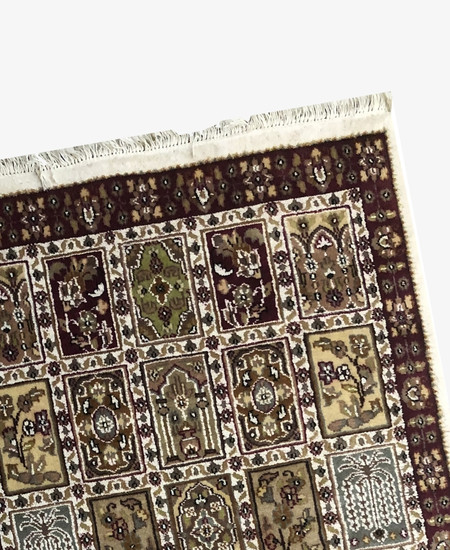
Pak Persian Carpets
The Pak Persian Carpets are also produced in Pakistan and made according to the official techniques but the design of these rugs are picked from Persian patterns like: Isfahan, Gardens etc. The carpets ground seems Persian but the knot density, texture and the dyes tells that it is a Pak Persian Carpet. They are frequently used for gifting and present purposes
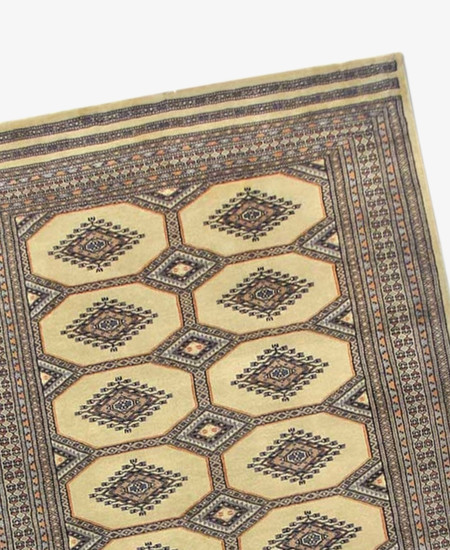
Jaldar Carpets
Jaldar carpets ar known for their symmetrical patterns with the soft texture. Similar to the classic Bokhara style, Jaldar carpets often has diamond-shaped or octagonal motifs with bold borders, usually woven in shades of red, ivory, blue, or gold.
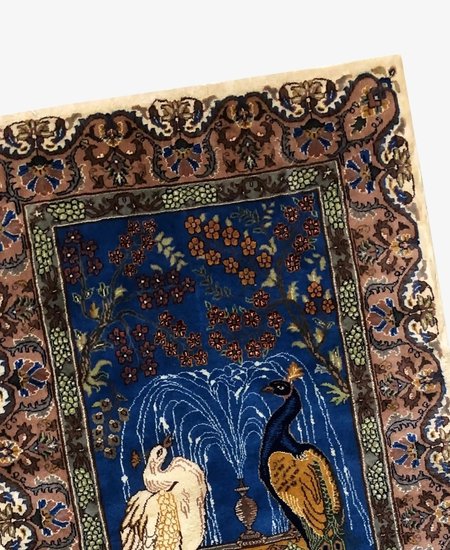
Pictorial Carpets
Pakistani Pictorial carpets are designed based on detailed scenes, figures, or landscapes, often inspired by historical, cultural, or religious themes. They are woven like a painting through including images such as famous landmarks, animals, people, or nature. Example: Hunting Carpets
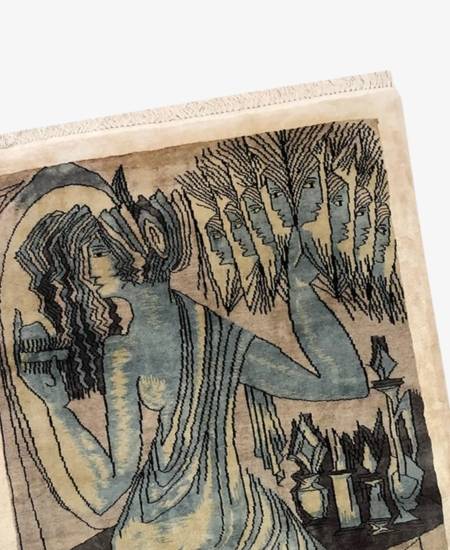
Customized Carpets
The customized carpets are made on demand for specified requirements. They can be a runner, wall hanging rug or based on a design. In the image you can see that the these customized carpets are based on the artwork of an artist.

Calligraphic Carpets
They are our introduced category in Pakistani carpets and rugs. These carpets are also known as Islamic carpets in which calligraphies of Qur'anic verses are shown, They need more care and focus due to the Islamic values and assistance.
Our Contribution to Pakistani rugs
As MWCarpets based in Pakistan, for being a Pakistani business we have introduced something new into the rug industry, we are specialized in customized and on demand carpets production, we’re also appreciated for this well.

The Largest Calligraphic Carpets
We have made a world record by creating the largest calligraphic carpets, which are based on the calligraphy of the well-known Pakistani artist: Syed Sadequain Ahmad Naqvi. The carpets are huge in size above 10x14(ft.) as seen in the image. Now present at the Provincial assembly of Sindh.

Your Imagination into Reality
We can proudly say that our experienced team can transform your imagined design or any existing design you have into a real rug through hand-knots. Doesn't matters if there's a scenery, place or a portrait. We have skill and experience of this customized field from year 2000.
Where to buy Pakistani carpets and rugs?
The handmade carpets are elegance for every home, It’s important to know the carpet before buying it or purchase it in assistance of a professional. But here’s a fact that theirs’s a natural originality feel comes from handmade carpet but be sure that you’re buying right carpet.
Local Markets
The handmade carpet are mostly sold in the biggest city of Pakistan ‘Karachi’, It serves as a central hub, many retailers came here from different cities and countries to buy Pakistani carpets in bulk. In local markets there’s two type of rug dealers: Wholesalers and retailers. If you want to buy a single carpet you have to go to retailers or if needed in quantity you can go to wholesalers for benefit. There’s so many local markets in Karachi, in which the most historical and well known is the Rafiq Center, present at Abdullah Haroon Road, Sadder.
Online Stores
In this modern era, now every business have their own website which serves as to spread their name and products/services. Similarly the carpets can be bought online through online stores but it’s crucial to understand the website’s authority first, Is store is legit? MWCarpets & Etsy are some trusted online stores for buying Pakistani carpets.
Pro Tip:
How to identify a genuine Pakistani Carpet?
It’s pretty easier to identify a Pakistani Rug, you will feel the bright colors, the soft and plushy texture and the cotton foundation coming our from top and bottom of carpet are some basic aspects for identifying a genuine Pakistani carpet. As you see it’s back the knotting and the same knot by knot coverage of whole back is the best way to identify a true Pakistani Carpet.
Carpet care and maintenance
Handmade carpets are fragile, specially the Pakistani carpets have a plushy and high pile which needs care to keep it’s look fresh. Regular vacuuming is important to remove dust and dirt from the surface immediately and prevent buildup in the fibers. Always use a vacuum without a beater bar to protect the hand-knotted weave. Rotate the carpet every few months and keep them away from sunlight. Avoid placing heavy furniture directly on the carpet for long periods, as it can leave permanent marks. In case of spills, blot immediately with a clean, dry cloth while not rubbing hardly. For deep cleaning, it’s best to use professional carpet cleaning services that understand nature of handmade rugs. With the right care, your Pakistani carpet will remain for you.
Do you know?
We exchange your old carpets with new once
We try our best to serve our customers, we have recently picked out an special service for you that if you have a damaged carpets, or a carpet you don’t wanted you can freely contact us. We will give you two options: Exchange with our new carpet or just sell it to us.
Are Pakistani Rugs an investment?
A Pakistani carpet requires a large amount of time and the rising amount of raw material cost is becoming the main reason for the changes in pricing of a Pakistan produced carpet. The working are also suffering from less profits and the increased amount of materials. The handmade carpets usually have a long life, they are durable due to hand knots. There’s so many stores and business that directly exchange your carpets or literally buy them and restore them to sell again on a higher price. It’s true that the carpet is a investment because it could be sold once puchased.
Pricing of Pakistani Carpets
The Pakistani carpets are pleasure their pricing are based on their specifications.
Knot Density:
The knot density is the measurement of the knots in a carpet, the term (KPSI) is used for measuring. The higher knot density it the carpet value and quality will be increased.
Material Quality:
Material quality plays a vital role in making a carpet durable and long-life there kinds of material available in markets in market
